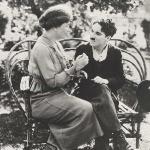 Four women outside the entrance to Union Station, lingering in the cool breeze on a sunny summer day.
Four women outside the entrance to Union Station, lingering in the cool breeze on a sunny summer day.
Two women perched behind displays of brochures: “Do You Know Jesus?” and “What About Your Afterlife?” query passersby.
One women in hijab, her religiosity also on display, watching the same crowd of travelers coming and going from their trains, sitting on a stone ledge opposite
The other woman next to her on the stone ledge, head full of talk about interfaith understanding, watching interfaith in action.
The mere presence of these four women is already a moment of religious pluralism, possible only in some places in the world. Chicago just happens to be one of them, the beneficiary of centuries of battles toward freedom of religion and expression. Not to mention struggles for women to be able move and act independently in the public realm. This is the “inter” of interfaith.
The women orient around religion differently – that much is visible with no words. This is the “faith” part. Christian missionary tracts, hijab, and the professor who carries it all in her uncovered head, bare arms and all (religious or not? who’s to know…).
They didn’t talk. They didn’t really inter-act. (They inter-were.)
What if they did interact? How might it go?
Negative encounters could have happened: Imagine a potentially uncomfortable encounter if the Christian missionary women approached the hijabi and said that she follows a false prophet. Imagine the hijabi woman criticizing the professor for flaunting her long brown hair in the very public sunshine. Imagine the professor telling the missionary women to give up their exclusivist theology.
Positive encounters could have happened: Imagine the professor engaging the Christian missionaries, asking them to tell the story about why they do this work. Imagine the hijabi and the professor working together to help the homeless man who collapsed in front of them. Imagine the Christian missionaries complimenting the hijabi on her beautiful scarf, noting how they too share a commitment to modest dress.
None of this happened. No one really inter-acted, beyond the mere fact of sharing space for about a half hour on a Thursday afternoon.
Teaching interfaith understanding is about equipping people for the positive encounters, and reducing the likelihood of the negative. It seems that the positive can be a simple compliment or it can be as vast as achieving world peace, and the negative can take the form of an offhanded insult or it can be as serious as violent armed conflict.
I hope we agree that we need more of the former.
For more on the teaching interfaith understanding seminar I had just attended, click here.
Image mine.
















